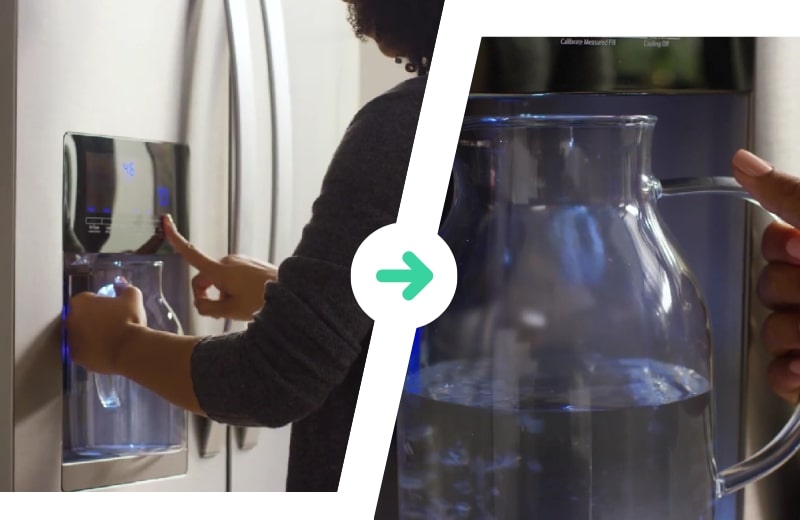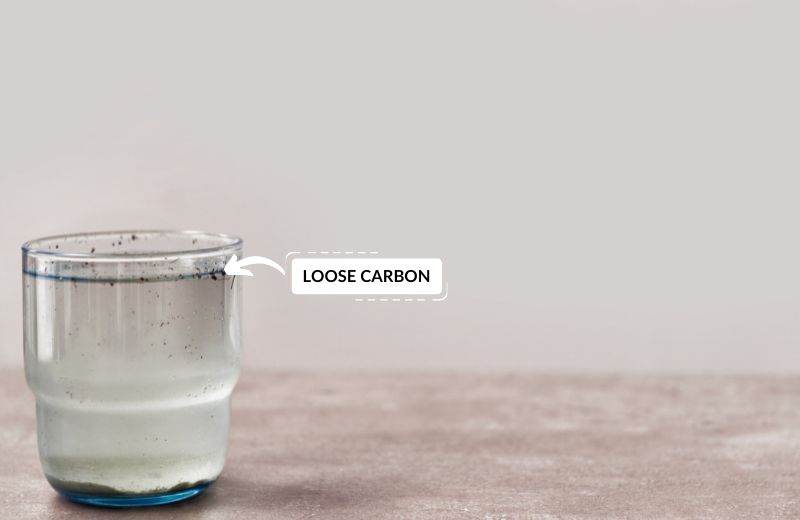Before you start using a new refrigerator water filter, you will need to flush the filter.
Flushing a refrigerator filter is an easy process. Once you learn the steps involved, you should remember them for the future.
In this quick guide, we’ve shared the step-by-step process of how to flush a refrigerator water filter.
📌 Key Takeaways:
- To flush a fridge filter, install the new filter, place a jug under the dispenser and fill it 2-3 times.
- Flushing a refrigerator water filter clears loose, large particles of carbon from the filter media, giving water a cleaner appearance and better quality.
- Most fridge filter manufacturers recommend flushing 3 to 6 gallons of water through the filter before use.
Table of Contents
📖 How to Flush Refrigerator Water Filter: Step-By-Step
To flush a new filter in your fridge, follow these steps:
Step 1: Gather Your Supplies
First, gather your materials. You will need:
- A towel or rag
- A new filter
- A pitcher or water jug (about two gallons is ideal)
Step 2: Install The Filter
If you haven’t already installed the new filter, do this next.
Most fridge filters are either installed inside the fridge above the top shelf or at the back of the fridge below the grille. In some cases, your filter may be installed somewhere along the fridge water line.
Remove the old filter, then slot or twist the new filter in its place.
Read our guide on how to change a fridge filter if you’ve never had to do this before. 👈

Step 3: Prepare To Flush The Filter
Once the filter is installed, prepare your supplies. Place the rag or towel on the floor beneath the water dispenser to catch any accidental spills.
Put the pitcher jug underneath the water dispenser. The jug will get heavy when it’s full, so ideally, it should be small enough to rest on the bottom holder, if your fridge has one. Otherwise, you’ll have to hold the jug as it fills.
Step 4: Press The Dispenser Button
To flush your filter, press the dispenser button or use the pitcher to push against the water dispenser lever. This will dispense filtered tap water from the fridge into the pitcher jug.
Wait until the jug is full of water before disengaging the dispenser button or lever.

Step 5: Discard And Repeat
Discard the filtered water down your sink drain or put it aside to use for other purposes (such as cleaning, washing dishes, or watering plants).
Repeat the process as many times as it takes to flush 3 to 5 gallons of water through the filter.
If you’re not sure what equates to this amount of water, just continue to flush the filter until you have clear, clean water.
📌 A note on fridges with an ice maker: If your fridge only has an ice maker and no water dispenser, you’ll need to dispense two full batches of ice to flush the filter.
🔎 Why Is Flushing A Refrigerator Water Filter Important?
Now you know how to flush a refrigerator water filter, let’s look at the reasons why flushing a fridge filter is necessary.
To Remove Carbon Particles
Most refrigerator water filters are made from a carbon block media that adsorbs (grabs onto) certain contaminants that affect the taste and smell of your water supply, along with a select few other contaminants (such as heavy metals).
When you first install this filter, it may contain flecks of carbon that have come loose during the manufacturing and shipping process. If you don’t flush the filter before use, you’ll notice that your drinking water looks cloudy or contains black spots, which might look off-putting.
📌 Carbon particles are safe to drink, but you probably prefer to drink crystal-clear water. Flushing the filter before use will clear out the loose carbon particles before you use the filter to treat water for drinking.

To Release Trapped Air
Installing a new water filter may also introduce air into the water line, causing an inconsistent water flow.
The filter itself may also contain trapped air bubbles, which can usually be resolved by flushing.
Flushing the filter should get rid of trapped air bubbles, so you get a consistent flow of water when you press the dispenser button.
Continue Reading:
- How to clean refrigerator water lines
- Learn how to safely remove and replace your fridge filter
- Read our review of the top 11 fridge filters of 2024
- Our complete guide on how to bypass a refrigerator water filter
❔ How to Flush Refrigerator Water Filter: FAQ
How much water does it take to flush a refrigerator filter?
It takes between 3 and 5 gallons to thoroughly flush a refrigerator filter. Different refrigerator filters may have slightly different requirements, so check your user manual for the manufacturer’s advice. If you haven’t got a way to measure by gallons, run water until it appears clear and free from black particles.
How long should I flush my water filter?
The time it takes to flush your fridge water filter depends on the flow rate of water from the dispenser. For most people, flushing a new water filter will take 5-10 minutes. Just continue dispensing water until you’ve reached the 3-5-gallon point or the water looks clean.
Do you have to flush refrigerator water filter?
No, you don’t have to flush the filter in your fridge’s water system before use. Most manufacturers recommend that you do flush the filter, though, to remove carbon particles from the water line and produce clear, clean water.
How often should you flush a refrigerator filter?
You should flush a refrigerator filter every time you replace the filter. Most fridge filters last 6 months. You’ll know when to replace the filter because the flow of water will drop noticeably, the water quality will worsen, and the indicator light may flash.
How do I flush the filter in a Whirlpool refrigerator?
Refrigerator filters in a Whirlpool fridge can be flushed by pressing and holding the water dispenser lever for 5 seconds, then releasing the lever for 5 seconds. Repeat this process until the water flow is steady and you have clear, good-quality water.
